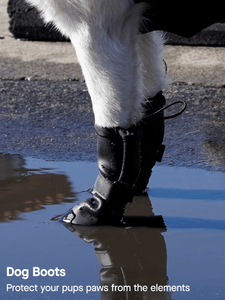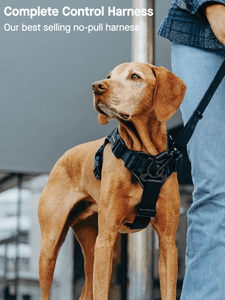Return to Blog
Raincoat resistance: Easy tips to help your dog embrace dry walks
By Canada Pooch on Oct 11, 2023
Rainy days can pose certain challenges for dog parents, one being the need to keep your pet dry and comfortable during walks. One practical solution to this problem is the introduction of a dog raincoat. However, getting your pup used to donning a raincoat can be a tricky endeavor. This article was created to guide you through the whys and how’s of introducing a raincoat to your dog, the training process, the importance of proper sizing for safe walks, and several useful tricks to facilitate the adjustment period. We will also explore the health and comfort benefits of using a raincoat for rainy day walks.
Why is introducing your dog to a raincoat important for rainy days?
Walking our pups is critical, come rain or shine. Rainy days can be troublesome for pet parents, especially those who hate dealing with a wet dog after coming back inside. The solution? A dog raincoat.
A raincoat is a great accessory that can make those rainy walks enjoyable for both you and your pup. However, introducing your dog to a raincoat can be a little daunting. However, with the right approach, your dog will be ready for a rainy walk in no time!
How can a raincoat keep your dog comfortable during a rainy walk?
Being wet can make the environment uncomfortable for our pups. A raincoat can provide a layer of protection between their fur and the rain, helping to keep them dry and comfortable throughout the walk.
Plus, a dry dog means a dry home! A raincoat minimizes the need for post-walk clean-ups and damp fur.
What are the health benefits of raincoats for walking dogs?
Contrary to popular belief, dogs can get cold, just like humans. A raincoat can help them maintain a proper body temperature during rainy walks.
What are the stages of raincoat training for dogs?
Introduction Stage
The introduction stage is all about letting your dog become familiar with the new raincoat in a relaxed, positive environment. Bring out the raincoat and allow your dog to sniff, touch, and explore it at their own pace. As they investigate the new item, talk to them in an encouraging, upbeat tone and provide tasty treats so they associate the raincoat with something pleasant. Let them satisfy their curiosity without forcing any interaction. This first exposure helps create a foundation of calm interest towards the raincoat. Go slowly and let your dog set the pace during this getting-to-know-you phase.
Desensitization Stage
In the desensitization stage, you'll gradually expose your dog to brief moments of contact with the raincoat to decrease any apprehension or excitement they may feel. Begin by merely draping the raincoat over your dog's back for a few seconds, then removing it and rewarding them with treats and praise. As your dog remains relaxed, slowly increase the length of time the raincoat lays on them before removing it, from 5 seconds to 15 seconds to 30 seconds, continuing praise and treats each time. The goal is to keep sessions positive and let your dog learn the raincoat is nothing to fear. If they become agitated, go back to a shorter duration. Patience prevents overwhelm during this stage.
Habituation Stage
Once your dog seems comfortable with the raincoat draped over them for up to a minute, it's time to level up to the habituation stage. In this phase, you'll start placing the raincoat on correctly but without fastening it. Lift each paw gently as you slide them into the leg holes and speak encouragingly as you slip the raincoat over their head and onto their back. At first, keep the sessions very brief, fastening, no straps or buckles. Provide treats and pets while they wear the unfastened raincoat, then remove it while they are calm. As your dog relaxes, gradually lengthen the period for wearing the coat. The goal is to reinforce that the raincoat is safe even when worn properly.
Conditioning Stage
In the conditioning stage, with your dog now content wearing the raincoat unfastened, you can begin to fasten it loosely. Slowly tighten the adjustable straps or fasten the hook and loop closures, rewarding your dog with treats for tolerating this new step. Keep the raincoat comfortable but secure in these sessions, which may start at just 30 seconds of wearing the loosely fastened coat. Through multiple positive sessions over days, aim to gradually tighten the coat until it is properly fitted but not restrictive. Practice having them walk around with you with it fastened. Stay upbeat and patient, giving praise and pets.
Reinforcement Stage
The final reinforcement stage bonds the raincoat with enjoyable outcomes for your dog. Once your dog is calmly allowing the raincoat to be fully fastened and worn for reasonable periods, put the raincoat on before fun activities like walks or car rides. This reinforces that the raincoat means something good is about to happen. Provide treats and encouragement as you outfit them before exiting. The raincoat now signifies pleasant things like outdoor playtime. Be patient during this stage, and go back to earlier stages if needed until your dog is totally comfortable sporting their stylish new rain gear!
How can positive reinforcement aid in raincoat introduction for dogs?
Positive reinforcement is an excellent strategy for training dogs. It involves rewarding your dog for positive behavior, making them inclined to repeat that behavior. In the case of the raincoat, giving your dog a treat, pat or praise each time they behave positively with the coat can lead to quicker and stress-free acceptance.
Remember, patience is key! Your pup may not accept the raincoat immediately, but consistency and positive reinforcement will surely help them embrace the new change.
How to safely walk dogs with raincoats during rainy days?
Introducing your dog to a raincoat involves training tips and tricks that can significantly enhance the experience during rainy walks. The key to a successful and safe walk with dogs in the rain is preparation. Whether it's a light drizzle or a heavy downpour, a raincoat can protect your dog from getting soggy and uncomfortable.
What gear to couple with a raincoat for a safe rainy walk with dogs?
Apart from a raincoat, other useful gear items include water-resistant boots to cover your dog's paw and a sturdy leash. Boots protect the dogs paw from getting soaked and prevents dirt from getting trapped in-between their paws.
Why is proper raincoat sizing important for safely walking dogs on rainy days?
Proper sizing is crucial for comfort and mobility. Measure your dog accurately – from their neck to the base of their tail, as well as around their chest and waist - to ensure you're getting the right size. Make sure to reference the manufacturers size guide in order to get the best fit.


